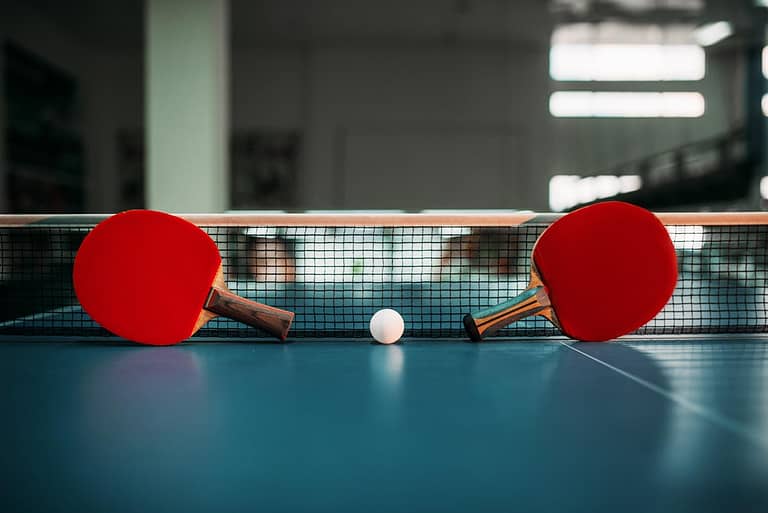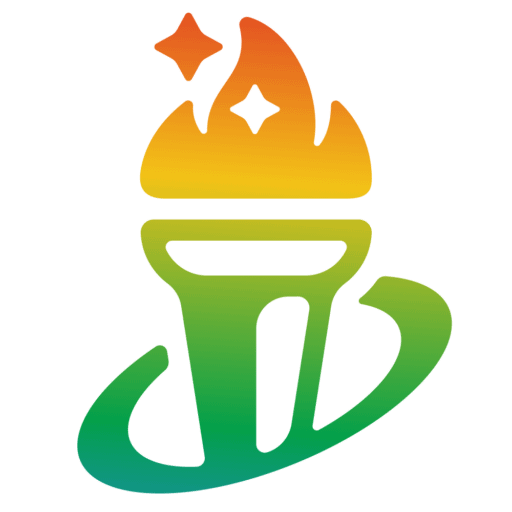What is Table Tennis? A Fun and Fast-Paced Sport
What is table tennis? Also called ping pong. It is an exciting racket sport. It’s played on a table with small paddles and a lightweight ball. It’s a game that’s easy to learn but hard to master. And it’s a lot of fun!

The Basics: What You Need to Know
Here’s what you need to play table tennis:
- A table (obviously!)
- A net
- Two or four paddles (depending on if you’re playing singles or doubles)
- A small, lightweight ball
The goal is simple: hit the ball over the net and onto your opponent’s side of the table. You win a point if your opponent can’t return the ball or if they make a mistake.
How to Play: Serves, Rallies, and Points
A game of table tennis starts with a serve. The server has to toss the ball up and hit it so it bounces on their side of the table once before going over the net. Then the receiver has to return the ball, and the rally begins!
The rally keeps going until one player can’t return the ball or makes a mistake. That’s when a point is scored. And the first player or team to reach 11 points (with a lead of at least two points) wins the game.
Different Types of Games: Singles, Doubles, and Mixed Doubles
You can play table tennis with two players (singles) or four players (doubles). In doubles, teammates take turns hitting the ball. There’s also mixed doubles, where each team has one male and one female player.
No matter what type of game you’re playing, the basic rules are the same. But the strategies and tactics can vary. They depend on how many players are involved.
Mastering the Table Tennis Serve: Techniques and Tips
The serve is one of the most important shots in table tennis. It’s your chance to start the rally off on your terms and put pressure on your opponent. Here are some tips for mastering your serve:
Different Types of Serves
There are lots of different types of serves in table tennis. Some of the most common ones are:
- Pendulum serve
- Backhand serve
- High toss serve
- Forehand spin serve
Each type of serve has its own strengths and weaknesses. You can use different spins. These are topspin, backspin, and sidespin. They make your serves even trickier.
Tips for a Great Serve
Here are some tips to help you improve your serves:
- Practice, practice, practice! The more you serve, the better you’ll get.
- Experiment with different types of serves and spins to keep your opponent guessing.
- Pay attention to your opponent’s strengths and weaknesses. Try to use them with your serves.
- Use your serve to set up your next shot. Think about where you want the ball to go after your opponent returns it.
The Art of the Table Tennis Rally: Strategies and Tactics
The rally is where the real action happens in table tennis. It’s a fast-paced battle of skill, speed, and strategy. Here are some tips for mastering the art of the rally:
Offensive vs. Defensive Play
There are two main styles of play in table tennis: offensive and defensive. Offensive players like to attack and take control of the rally. Defensive players prefer to let their opponent make mistakes.
Some players are all-rounders. They can switch between offense and defense as needed. It’s important to find a style that works for you and suits your strengths.
Spin and Speed: The Keys to Success
Spin and speed are two of the most important factors in table tennis. A shot with a lot of spin can be hard to return, while a fast shot can catch your opponent off guard.
Here are some common spin techniques:
- Topspin: The ball rotates forward, causing it to dip down after bouncing.
- Backspin: The ball rotates backward, causing it to slow down and bounce up after hitting the table.
- Sidespin: The ball rotates sideways, causing it to curve left or right after bouncing.
To generate more speed, you need to use your whole body and transfer your weight into the shot. Footwork is also important for getting into position quickly.
Shot Selection: Choosing the Right Shot for the Situation
Knowing which shot to use in a given situation is a key part of table tennis strategy. Here are some common shots:
- Drive: A fast, flat shot that’s hit with a slight topspin.
- Loop: A heavy topspin shot that’s usually hit from far behind the table.
- Push: A backspin shot that’s used to keep the ball low and slow.
- Chop: A heavy backspin shot that’s often used by defensive players.
- Block: A quick, defensive shot that’s used to return a fast shot.
- Lob: A high, defensive shot that’s used to give yourself time to recover.
- Flip: A quick, offensive shot that’s used to attack a short ball.
- Smash: A powerful, offensive shot that’s used to end the rally.
The key is to choose the right shot based on the spin, speed, and placement of your opponent’s shot. And don’t be afraid to mix things up and try new shots to keep your opponent guessing!
Table Tennis Training: Drills and Exercises to Improve Your Game
If you want to get better at table tennis, you need to practice regularly. Here are some drills and exercises that can help you improve your skills:
Basic Drills
- Forehand and backhand drives: Hit these against a wall or with a partner.
- Footwork drills: Practice moving quickly and efficiently around the table.
- Serve practice: Work on different types of serves and practice serving consistently.
Advanced Drills
- Multiball: Have a partner or coach feed you balls rapidly so you can practice your shots.
- Use a table tennis robot to practice returning different spins and speeds..
- Play conditioned games. These have specific rules or restrictions to work on skills.
Off-Table Training
Table tennis isn’t just about what happens on the table. You can also improve your game with off-table training:
- Get in shape by working on your strength, speed, and endurance. Do exercises like running, jumping rope, and weightlifting.
- Train your mind. Practice visualization and meditation. Use other mental techniques to improve your focus and confidence.
- Analyze videos. Watch your own play or pros to find strengths and weaknesses.

Table Tennis Tournaments and Competitions: From Local to Olympic
Ping pong isn’t just a hobby. It’s also a competitive sport with tournaments at every level. Here’s what you need to know:
Local and Regional Tournaments
Most cities and regions have local table tennis clubs that host regular tournaments. These are a great way to test your skills against other players and meet new people who share your love of the sport.
National and International Competitions
If you love table tennis, you can compete in national and world competitions. The International Table Tennis Federation (ITTF) governs the sport. It organizes major events like the World Championships and the World Cup.
Olympic Table Tennis
Table tennis has been an Olympic sport since 1988. It awards medals in singles and doubles for men and women. The best players in the world compete for the ultimate prize in front of a global audience.
The Mental Game in Table Tennis: Focus, Concentration, and Mindset
Table tennis isn’t just a physical game – it’s also a mental one. Here are some tips for improving your mental game:
Focus and Concentration
Table tennis is a fast-paced sport that requires intense focus and concentration. Here are some tips for staying focused:
- Take deep breaths and try to relax between points.
- Visualize successful shots and positive outcomes.
- Stay in the present moment and don’t dwell on past mistakes.
Mindset and Attitude
Your mindset and attitude can have a big impact on your performance in table tennis. Here are some tips for developing a positive mindset:
- Set realistic goals for yourself and celebrate your progress.
- Focus on the process, not just the outcome.
- Embrace challenges and view them as opportunities to learn and grow.
- Stay positive and don’t get too down on yourself when things don’t go your way.
Table Tennis Legends: Iconic Players and Their Impact on the Sport
Throughout table tennis history, many legendary players have left their mark on the sport. Here are just a few:
Jan-Ove Waldner (Sweden)
Known as “The Mozart of Table Tennis,” Waldner is widely regarded as one of the greatest players of all time. He won two Olympic gold medals and six World Championships titles in his career.
Ma Long (China)
Ma Long is a modern-day legend who has dominated the sport in recent years. He has won three Olympic gold medals and five World Championships titles. He is known for his strong forehand and mental toughness.
Deng Yaping (China)
Deng Yaping is one of the most successful female players in history. She won four Olympic gold medals and many World Championships titles. She was known for her speed, agility, and tactical brilliance.
These are just a few examples. Many incredible players have shaped table tennis. Their legacy continues to inspire new generations of players around the world.
Table Tennis and Physical Fitness: Benefits and Training Regimens
Playing table tennis isn’t just fun – it’s also great for your physical health and fitness. Here are some of the benefits:
Cardiovascular Health
Table tennis is a fast-paced sport that requires quick movements and constant motion. This can help improve your heart health. It does so by raising your heart rate and blood flow.
Hand-Eye Coordination
Table tennis requires precise hand-eye coordination to hit the ball accurately. Playing regularly can help improve your coordination and reaction time.
Agility and Reflexes
Table tennis players need to be quick on their feet and able to change direction rapidly. This can help improve your agility and reflexes over time.
Training Regimens
To get the most out of table tennis for fitness, you must train regularly. Here are some tips:
- Warm up before playing to prevent injury and improve performance.
- Focus on footwork drills to improve your speed and agility.
- Practice different types of shots to improve your overall game.
- Add strength training exercises. These include squats, lunges, and push-ups. They help you build muscle and gain power.
- Don’t forget to stretch and cool down after playing to prevent soreness and stiffness.
By training regularly and playing table tennis, you can enjoy the sport’s physical benefits!

